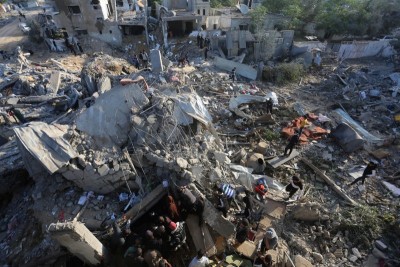
Earth’s health declining ‘faster than thought’ but action by governments can reverse trend – UN
The Global Environmental Outlook (GEO-6): Regional Assessments is a compilation of six separate reports, which provide highly detailed examinations of the environmental issues affecting each of the world’s six regions: the Pan-European region, North America, Asia and the Pacific, West Asia, Latin America and the Caribbean, and Africa, the UN Environment Programme (UNEP) said in a press release.
Published ahead of the UN Environment Assembly, taking place in Nairobi, Kenya, from 23-27 May, the regional assessments, which involved 1,203 scientists, hundreds of scientific institutions and more than 160 governments, find that the world shares a host of common environmental threats that are rapidly intensifying in many parts of the world.
Across the planet, climate change, the loss of biodiversity, land degradation and water scarcity are growing problems that need to be urgently addressed if the world is to achieve the goals set out in the 2030 Agenda for Sustainable Development, the studies find.
“On Thursday, thanks to this report, we now know more about the state of the world’s environment than ever before,” said UNEP Executive Director Achim Steiner. “It is essential that we understand the pace of environmental change that is upon us.”
The assessments find that there is still time to tackle many of the worst impacts of environmental change, such as the damage to marine ecosystems and the rising level of air pollution, which has become one of the world's most widespread environmental health risks.
As one of the first areas of the world to experience the impacts of climate change, the Arctic region serves as a barometer for change in the rest of the world. Warming in the Arctic has increased at twice the global average since 1980.
The largest contributions to global glacier ice loss during the early 21st century were from glaciers in Alaska, the Canadian Arctic, and the periphery of the Greenland ice sheet, as well as in the Southern Andes and Asian mountains. Together these areas account for more than 80 per cent of the total ice loss.
The 30 centimetres of sea level rise off New York City since 1900 likely expanded Hurricane Sandy’s flood area
The 30 centimetres of sea level rise off New York City since 1900 likely expanded Hurricane Sandy’s flood area by approximately 65 square kilometres, flooding the homes of more than 80,000 additional people in New York and New Jersey alone.
The prospect for impacts such as these to worsen in both the near and long term constitutes a priority issue for North America.
Last year, the Asia-Pacific continued to be the world's most disaster prone region. About 41 per cent of all natural disasters reported over the last two decades occurred in the Asia-Pacific region, which also accounted for 91 per cent of the world’s deaths attributable to natural disasters in the last century.
The main driver for accelerating domestic material consumption is the expanding middle class. The size of the global middle class is projected to increase from 1.8 billion in 2009 to 4.9 billion in 2030 with most of this growth coming from Asia.
In the Latin American and Caribbean region, most of the cities in the region for which data are available have concentrations of particulate matter (PM) above World Health Organisation (WHO) guidelines.
The region’s urban population increased by more than 35 million people between 2010 and 2015, and is expected to climb to a total of 567 million persons by 2025. More than 100 million people already live in areas where they are at risk from air pollution.
In West Asia, continuous conflict and the mass displacement of people throughout the region are also triggering severe environmental impacts that are endangering the health of people. Heavy metals from explosive munitions and radiation from missiles have leached into the environment.
The 2.97 million refugees in Lebanon, Jordan, Yemen and Iraq are placing an immense environmental burden on the region, producing about 1,440 tonnes of waste per day in 2015
The 2.97 million refugees in Lebanon, Jordan, Yemen and Iraq are placing an immense environmental burden on the region, producing about 1,440 tonnes of waste per day in 2015, overwhelming governments and increasing the risk of disease outbreaks.
In Africa, the second largest continent in the world, land is the most prized asset for food production, nutritional health and economic development. Worryingly, about 500,000 square meters of land in Africa is being degraded due to soil erosion, salinization, pollution and deforestation. This land degradation can damage agricultural productivity, nutrition and human health.
The recommendations made in the reports include: to improve gathering, processing and sharing of data and information to inform decision-making; enhance sustainable consumption and production to reduce environmental pressures by addressing drivers associated with manufacturing processes and consumer demand; invest in urban planning, such as through the better use of environmentally sound infrastructure and clean transport; reduce dependence on fossil fuels, and diversify energy sources.
Low-carbon, climate-resilient choices in infrastructure, energy and food production coupled with effective and sustainable natural resource governance are key to protecting the ecological assets that underpin a healthy society.
Photo: World Bank/Flore de Preneuf
Source: www.justearthnews.com
Support Our Journalism
We cannot do without you.. your contribution supports unbiased journalism
IBNS is not driven by any ism- not wokeism, not racism, not skewed secularism, not hyper right-wing or left liberal ideals, nor by any hardline religious beliefs or hyper nationalism. We want to serve you good old objective news, as they are. We do not judge or preach. We let people decide for themselves. We only try to present factual and well-sourced news.







